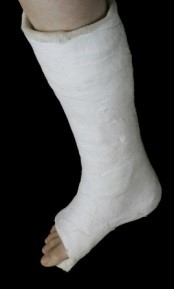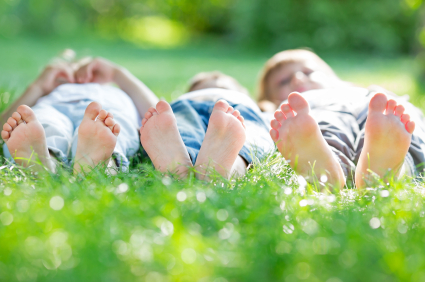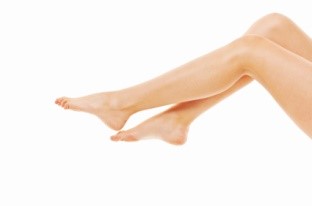April 2015
Footballer Out for the Season due to Broken Ankle
 Footballer Emad Sahab of Al Orubah sustained a severe broken ankle after tumbling in a game against Al Shoalah. The ankle twisted 180 degrees.
Footballer Emad Sahab of Al Orubah sustained a severe broken ankle after tumbling in a game against Al Shoalah. The ankle twisted 180 degrees.
The game was quickly halted for a temporary amount of time as Sahab’s teammates witnessed the occurrence in great horror. Al Orubah, Sahab’s team, eventually continued their match to win 2-0. The team’s success, however, was overshadowed by the incident and Sahab’s resulting injury.
Broken ankles are very painful. If you have any concerns contact one of our podiatrists of North Fork Podiatry. Our doctors will treat your foot and ankle needs.
Broken Ankles
A broken ankle is experienced when a person fractures their tibia or fibula in the lower leg and ankle area. Both these bones are attached at the bottom of the leg and combine to form what we know to be our ankle.
When a physician is referring to a break of the ankle, he or she is usually referring to a break in the area where the tibia and fibula are joined to create our ankle joint. Ankles are more prone to fractures because the ankle is an area that suffers a lot of pressure and stress. There are some obvious signs when a person experiences a fractured ankle and the following symptoms may be present.
Symptoms of a Fractured Ankle
- Excessive pain when the area is touched or when any pressure is placed on the ankle
- Swelling around the area
- Bruising of the area
- Area appears to be deformed
If you suspect an ankle fracture, it is recommended to seek treatment as soon as possible. The sooner you have your podiatrist diagnose the fracture, the quicker you’ll be on the way towards recovery.
If you have any questions please feel free to contact our offices located in East Brunswick and Monroe Township, NJ. We offer the newest diagnostic tools and technology to treat your foot and ankle needs.
Read more about broken ankles.
Keeping Children's Feet Healthy
Having healthy feet in childhood can help prevent medical problems later in life, namely in the back and legs. As children grow, their feet require different types of care from birth to school-age.
Although babies do not walk yet, it is still very important to take care of their feet.
- Avoid putting tight shoes or socks on his or her feet
- Allow the baby to stretch and kick his or her feet to feel comfortable
As a toddler, kids are now on the move and begin to develop differently. At this age toddlers are getting a feel for walking, so don’t be alarmed if your toddler is unsteady or ‘walks funny’. Be sure the child wears comfortable and protective shoes so that they can grow into their feet properly.
As your child gets older, it is important to teach them how to take care of their feet
- Show them proper hygiene to prevent infections such as fungus
- Be watchful of any pain or injury
- Have all injuries checked by a doctor as soon as possible
- Comfortable, protective shoes should always be worn, especially at play
Children of all ages are constantly developing and growing, and as a parent you want to make sure that nothing is hindering their maturation. This includes caring for their feet, as healthy feet are important in order to live a normal, fulfilling life.
Greenwood Elementary School Students Receive Proper Fitting Shoes
 Nonprofit company Shoes That Fit has been partnering with schools across the country to ensure that students are wearing shoes that properly fit. Recently twenty-five members of Sole Fit Club visited Greenwood Elementary School where more than 100 students were fitted with the proper fitting shoe.
Nonprofit company Shoes That Fit has been partnering with schools across the country to ensure that students are wearing shoes that properly fit. Recently twenty-five members of Sole Fit Club visited Greenwood Elementary School where more than 100 students were fitted with the proper fitting shoe.
The goal of the event was to improve their self-esteem while simultaneously allowing them to obtain better focus on their school work because of they now have shoes that fit correctly. “We can tell kids to wash their feet to avoid infection and change their socks every day, but when they don’t have proper shoes, their foot health is still not going to be good,” said event organizer Kathy Grigoropoulos.
Making sure that your child has the proper foot health is important as they grow up. If you have any questions contact one of our podiatrists of University Foot and Ankle Center, LLC. Our doctors will treat your child’s foot and ankle needs.
Keeping Children's Feet Healthy
Having healthy feet in childhood can help prevent medical problems later in life, namely in the back and legs. As children grow, their feet require different types of care from birth to school-age.
Although babies do not walk yet, it is still very important to take care of their feet.
- Avoid putting tight shoes or socks on his or her feet
- Allow the baby to stretch and kick his or her feet to feel comfortable
As a toddler, kids are now on the move and begin to develop differently. At this age toddlers are getting a feel for walking, so don’t be alarmed if your toddler is unsteady or ‘walks funny’. Be sure the child wears comfortable and protective shoes so that they can grow into their feet properly.
As your child gets older, it is important to teach them how to take care of their feet
- Show them proper hygiene to prevent infections such as fungus
- Be watchful of any pain or injury
- Have all injuries checked by a doctor as soon as possible
- Comfortable, protective shoes should always be worn, especially at play
Children of all ages are constantly developing and growing, and as a parent you want to make sure that nothing is hindering their maturation. This includes caring for their feet, as healthy feet are important in order to live a normal, fulfilling life.
If you have any questions please feel free to contact our offices located in East Brunswick and Monroe Township, NJ. We offer the newest diagnostic and treatment technologies for all your foot and ankle needs.
Read More about Keeping Children’s Feet Healthy
Study Finds Older Runners Have a Harder Time Adjusting to Barefoot Running
 A new study suggests that acclimating to barefoot running may be more difficult for experienced older runners than younger runners. This difficulty transitioning may increase an older runner’s risk for injury while running without shoes. Barefoot running has come into popularity in recent years due to studies suggesting that the trend could decrease how hard the foot strikes the ground and lessen injuries.
A new study suggests that acclimating to barefoot running may be more difficult for experienced older runners than younger runners. This difficulty transitioning may increase an older runner’s risk for injury while running without shoes. Barefoot running has come into popularity in recent years due to studies suggesting that the trend could decrease how hard the foot strikes the ground and lessen injuries.
Enthusiasts for the trend claim that barefoot runners automatically shift the way they run to land on the forefoot, which places less strain on joints. Recent research, however, has shown that older runners who try barefoot running still maintain a heel landing and do not naturally move to a forefoot landing; increasing their risk for injuries.
Barefoot running is a new trend that is not for everyone. For more information about barefoot running contact one of our podiatrists of University Foot and Ankle Center, LLC. Our doctors will treat your foot and ankle needs.
Barefoot Running
Barefoot running is a fairly popular trend in the running world. More than just simply ‘running without shoes,” barefoot running affects the way your feet hit the ground and your overall posture. Barefoot runners land on the front part of their feet as opposed to those who wear shoes, who usually strike their heel as they hit the ground.
Barefoot running contains many advantages, including:
- A lower risk for ankle and foot injuries
- Improvement in balance and body posture
- Strengthens muscles in the lower legs, ankles and feet that are not normally worked when wearing shoes
There are also some disadvantages to barefoot running, which include:
- Lack of shoes increases the risk of incurring blisters, scrapes, bruises and cuts
- Risk of Achilles tendonitis as a result of landing on the front of your feet constantly
- Needing time and transition to adjust as the switch cannot be automatic
Start on even, flat surfaces and consider investing in minimalist running shoes. Minimalist running shoes provide the ‘feel’ of barefoot running while affording the same protection you get from wearing shoes. Barefoot running can be safe and enjoyable with the proper planning and transition.
If you have any questions please feel free to contact our offices located in East Brunswick and Monroe Township, NJ. We offer the newest diagnostic tools and technologies to treat your foot and ankle needs.
Foot Therapy for Sports Injuries
Whether in practice or in the game, athletes put their bodies through great stress. Some sports tax and demand more from the body than others, but every sport has an element of inorganic movement or unnatural motion. For ample, in softball, a pitcher winds up and flings her body with incredible amounts of dexterity in order to get the most ideal velocity out of her pitches. This motion, incredibly taxing on the body, can cause serious injury.
With regards to athletic injuries, one of the most common issues resides in the feet. Whether a damaging fracture that leaves athletes sidelined or simple turf toe, foot injuries can be very frustrating and painful. Regardless of sport, athletes require use of their feet in some fashion. This is why foot therapy is so vital in order to get athletes back on the right track and training again to return to the field.
No matter the injury, the best way to speed up the recovery period is to receive physical therapy. Physical therapy as a founded practice has proven to work for millions of people. Physical therapists are trained specifically to help people return to proper form from any injury, having gone through years of schooling in order to do so.
During physical therapy, you will go through organized training in order to get back into form. Sometimes training can be quite difficult, especially in the beginning when there is more pain and the foot feels awkward. To alleviate that you will do basic twisting and stretching exercises in order to get flexibility and foot mobility back up. The therapist will also massage the injured area in order to activate and relax muscles. Over time you will eventually move up to strengthening exercises, designed specifically so that activation of the injured area is ensured. Foot therapy for sports is a modern science miracle. Devoid of fancy chemicals and terminology, physical therapy is an evidence based practice that is well designed as any other. Due to huge advancements and knowledge of muscles and joints, physical therapists can turn catastrophic injuries around so athletes can return to the game once more.
Katy Perry Receives Cupping Therapy for her Foot Pain
 For years celebrities have been seen with cupping marks all over their backs and necks to reduce shoulder pain, but now Katy Perry is the latest celeb to use cupping in a new way: for her feet. Celebrities are always seen walking the red carpet with drastically high heels that can cause pain in many parts of the foot; the singer is getting treated for pain on the balls of the feet. The therapy treatment is said to detoxify the body and improve circulation. The star even posted a photo to social media stating, “Getting my foot cupped cause: fashion week.”
For years celebrities have been seen with cupping marks all over their backs and necks to reduce shoulder pain, but now Katy Perry is the latest celeb to use cupping in a new way: for her feet. Celebrities are always seen walking the red carpet with drastically high heels that can cause pain in many parts of the foot; the singer is getting treated for pain on the balls of the feet. The therapy treatment is said to detoxify the body and improve circulation. The star even posted a photo to social media stating, “Getting my foot cupped cause: fashion week.”
Foot therapy is a good idea for those with chronic pain and to recovery from foot injuries. To get consultation for foot therapy, contact one of our podiatrists of University Foot & Ankle Center, LLC. Our doctors will treat your foot and ankle needs.
Most common injuries
People who are constantly on their feet are prone to a variety of injuries. Therefore, it is important to take part in physical therapy in order to get back on the right track quickly.
What to do when injured
Physical Therapy – This specialized treatment will focus on the affected area, speeding up recovery and the overall healing process. This is important for those wanting to get back into the game quickly. It is a proven method that has helped millions of people return from any injury.
During physical therapy you will undergo regimented training to get back into full form. Training is often very difficult, especially at first when the foot feels weak. These are some steps physical therapy often involves:
- Basic stretching & twisting exercises – getting the feet’s mobility and flexibility up.
- Massaging – the therapist will massage the injured area in order to activate the muscles and relax them.
- Strengthening Exercises – this allows the muscles in the affected area to regain their full strength, a vital step towards full recovery.
With the advancements in technology and greater knowledge of how muscles and joints work, physical therapists can turn things around dramatically.
If you have any questions, please feel free to contact our offices located in New Jersey. We offer the newest diagnostic and treatment technologies for all your foot and ankle needs.
Featured Articles
- April 2024
- March 2024
- February 2024
- January 2024
- December 2023
- November 2023
- October 2023
- September 2023
- August 2023
- July 2023
- June 2023
- May 2023
- April 2023
- March 2023
- February 2023
- January 2023
- December 2022
- November 2022
- October 2022
- September 2022
- August 2022
- July 2022
- June 2022
- May 2022
- April 2022
- March 2022
- February 2022
- January 2022
- December 2021
- November 2021
- October 2021
- September 2021
- August 2021
- July 2021
- June 2021
- May 2021
- April 2021
- March 2021
- February 2021
- January 2021
- December 2020
- November 2020
- October 2020
- September 2020
- August 2020
- July 2020
- June 2020
- May 2020
- April 2020
- March 2020
- February 2020
- January 2020
- December 2019
- November 2019
- October 2019
- September 2019
- August 2019
- July 2019
- June 2019
- May 2019
- April 2019
- March 2019
- February 2019
- January 2019
- December 2018
- November 2018
- October 2018
- September 2018
- August 2018
- July 2018
- June 2018
- May 2018
- April 2018
- March 2018
- February 2018
- January 2018
- December 2017
- November 2017
- October 2017
- September 2017
- August 2017
- July 2017
- June 2017
- May 2017
- April 2017
- March 2017
- February 2017
- January 2017
- December 2016
- November 2016
- October 2016
- September 2016
- August 2016
- July 2016
- May 2016
- April 2016
- February 2016
- January 2016
- December 2015
- November 2015
- September 2015
- August 2015
- July 2015
- June 2015
- May 2015
- April 2015
- March 2015
- February 2015
- January 2015
- December 2014
- November 2014
- October 2014
- September 2014
- August 2014
- July 2014
- June 2014




